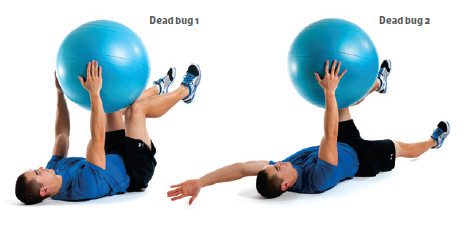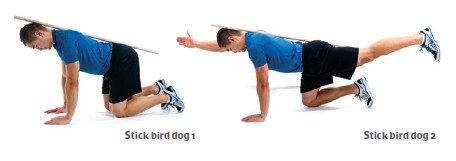5 exercises to correct lower cross syndrome in cyclists
Although cycling isn’t lounging on the couch, it is still classified as a hip flexion activity. Lower cross syndrome is characterized by tight low back extensors, tight hip flexors, and inhibition or weakness of the abdominals and gluteals.

by Carla Cupido and Jon-Erik Kawamoto
Cyclists have notoriously tight hamstrings. Here’s a quick test: lie on your back with your knees bent and feet flat on the floor. Touch the back of your thighs lightly with your fingertips and lift your butt off the floor until you have a straight line from your knees to your shoulders. Did your hamstrings contract immediately? Are they hard as rocks? If so, it means your hamstrings are too tight and dominant, while your gluteals are too weak or inhibited.
A weak muscle lacks strength for normal function and an inhibited muscle doesn’t receive adequate information from the nervous system for normal function. Regardless of the type of riding you do, you spend a lot of time hunched over the bike (hip flexion), which predisposes you to developing muscular imbalances as seen in a condition known as lower cross syndrome. This condition is often associated with the seated posture. Although cycling isn’t lounging on the couch, it is still classified as a hip flexion activity. Lower cross syndrome is characterized by tight low back extensors, tight hip flexors, and inhibition or weakness of the abdominals and gluteals.
Imagine the deep hip flexors as two strings attached to your lower back, crossing the front side of your Pelvis—one connecting to your right groin and the other to your left. If the strings are shortened, your upper body gets pulled toward your lower body (inducing hip flexion). Since we don’t want to walk around bent in half, we adjust by increasing the arch in our lower backs to maintain an upright position. This leads to tight hamstrings and the symptons listed above. The imbalance results in inefficient cycling mechanics and can lead to degenerative conditions such as arthritis due to altered loads on the joints, lumbar spine facet joint irritation, muscle strains and lumbar spine disc injuries.
Exercises
Add these exercises to your weekly routine to reduce risk of injury and improve performance.
Hip bridge

Why To increase gluteal recruitment, minimizing hamstring dominance during hip extension
How Lie on your back with a band wrapped around your feet and knees. With your feet flat, lift your toes up and dig your heels into the floor. This will activate your quadriceps and help reduce hamstring activation. Brace your abs as if you were preparing to receive a punch and squeeze your glutes. Lift your hips so there is a straight line from your knees to your shoulders. Keep your heels pushing away and open your knees and feet apart. Hold for six seconds. Perform 10 repetitions for two sets.
Hip flexor stretches with core activation

Why To stretch out the deep hip flexors, correcting muscle shortening caused by time in the saddle
How To target the superficial hip flexors, kneel on a mat with your right knee. Think tall while pressing straight down onto a box or stick in front of you. Don’t hold your breath, but squeeze your right butt cheek as you shift your weight forward to your left foot. Keep pressing down on the stick – you should feel a deep stretch in the front of your right hip.
To target the deep hip flexors, assume the sameposition as above, but with your right knee off theground. Reach up and to the left with your rightarm. You should feel this through your right lowerabdomen and hip flexors.
Hold both for 30-60 seconds; repeat as much as necessary and daily and perform on both sides.
Dead bug

Why To develop core control
How Lie on your back while holding an exercise ball with your knees and hands. Your arms should be straight and you should have 90 degrees at your hips and knees. Maintain that proper lumbar curve while reaching one arm and the opposite leg out. Don’t let your back move as you alternate sides. Perform four 30 second sets daily.
Stick front plank

Why To increase core stability
How Get on your elbows and toes with a dowel rod on your back – it should touch the back of your head, upper back and the top of your hips. Engage your core by bracing as in the Dead bug. Keep the three points of contact and do not let your low back arch away from the stick. Hold for 10 seconds and progress to six repetitions – perform three to five sets every other day.
Stick bird dog

Why To increase core stability
How Get on your hands and knees with the dowel rod on your back. Engage your core by bracing as in the Dead bug. Keep the three points of contact while reaching one arm and the opposite leg out. Maintain the three points of contact and do not let your lower back arch away from the stick. Hold for six seconds and repeat on the other side. Alternate sides for 60 seconds and do three to five sets. Perform every other day.
Carla Cupido is a chiropractor and Jon-Erik Kawamoto is a strength and conditioning specialist. Both are from Vancouver, B.C. and treat cyclists in their practices.
